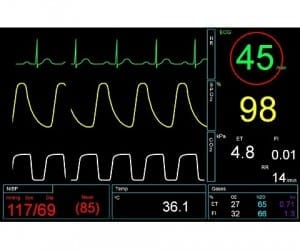
 This post is part 2 of epistaxis dogma. In the first post, we discussed the (dis)utility of prophylactic antibiotics in patients with epistaxis who require nasal packing. Here, we will take on dogma #2:
This post is part 2 of epistaxis dogma. In the first post, we discussed the (dis)utility of prophylactic antibiotics in patients with epistaxis who require nasal packing. Here, we will take on dogma #2:
Dogma #2: Patients with posterior packs for epistaxis should be admitted to the ICU for continuous monitoring due to the risk of life-threatening bradydysrhythmias.
Unfortunately, the literature here is even sparser than with prophylactic antibiotics. An extensive literature search (paging research librarian) turned up two articles that were repeatedly cited.
Cassisi NJ et al. Changes in arterial oxygen tension and pulmonary mechanics with the use of posterior packing in epistaxis: a preliminary report. Laryngoscope 1971; 81(8): 1261-6. PMID: 5569677
 This article was a case series of 20 patients who had severe epistaxis necessitating posterior packing. This article is often quoted as the “original evidence” of bradydysrhythmias. After scouring the text, the words bradydysrhythmia, bradycardia or arrhythmia never turn up. There’s no mention of any cardiac events at all.
This article was a case series of 20 patients who had severe epistaxis necessitating posterior packing. This article is often quoted as the “original evidence” of bradydysrhythmias. After scouring the text, the words bradydysrhythmia, bradycardia or arrhythmia never turn up. There’s no mention of any cardiac events at all.
Zeyyan E et al. The effects on cardiac function and arterial blood gas of totally occluding nasal packs and nasal packs with airway. Laryngoscope 2010; 120: 2325-2330. PMID: 20938948
In this study of 39 patients with posterior packs (unilateral or bilateral) the authors showed that mean heart rate was slightly lower after packing but no bradycardic events occurred.
So if there’s no evidence to this myth, does that mean patients with posterior packs don’t need a higher-level of care? Not necessarily.
When we look back at the Cassisi article, the authors were actually looking at changes in PaO2 and PaCO2. They found a significant decrease in PaO2 after packing (22 mm Hg) and no difference in PaCO2. Of note, all of the patients were sedated so the pack may not have been the issue. A subsequent study found that in a group of 19 patients with posterior packs and over 1200 hours of observation there were only 2 episodes of desaturation and one was in a patient with massive hemorrhage (Loftus 1994)
 Before we bury the ICU admit completely, let’s look at one last article:
Before we bury the ICU admit completely, let’s look at one last article:
Viducich RA et al. Posterior epistaxis: clinical features and acute complications. Acad Emerg Med 1995; 25(5): 592-6. PMID: 7741333
This study found that in 88 patients with posterior epistaxis, 16 required surgical intervention after packing. Another way of saying this is: 18.2% of patients with posterior packing required a surgical intervention, an almost 1 in 5 rate. That’s a high rate of decompensation and may justify placing these patients in a closely monitored setting for signs of increased bleeding.
A summary article by Corrales noted that while there’s no good evidence to defend the uniform admission of all patients with posterior packs to the ICU, it appears that the more comorbid conditions the patient has, the more likely they are to decompensate and require surgery (Corrales 2013).
Summary: There is no evidence to defend the classic teaching that patients with posterior nasal packing are susceptible to life-threatening bradydysrhythmias.
The Bottom Line: Most patients with posterior epistaxis have significant comorbid conditions; that’s why they got posterior epistaxis in the first place. Healthy patients don’t tend to get posterior nosebleeds. Patients with posterior epistaxis are more likely to be on anticoagulants, antiplatelet agents, have blood dyscarasias or anatomical abnormalities (i.e. Osler-Weber-Rendu syndrome). I maintain a low threshold for placing these patients in a level of care with close monitoring and frequent reassessment.
Post Peer Reviewed By: Salim Rezaie, MD (Twitter: @srrezaie)
References
- Cassisi NJ et al. Changes in arterial oxygen tension and pulmonary mechanics with the use of posterior packing in epistaxis: a preliminary report. Laryngoscope 1971; 81(8): 1261-6. PMID: 5569677
- Zeyyan E et al. The effects on cardiac function and arterial blood gas of totally occluding nasal packs and nasal packs with airway. Laryngoscope 2010; 120: 2325-2330. PMID: 20938948
- Loftus BC et al. Epistaxis, medical history and the nasopulmonary reflex: what is clinically relevant. Otolaryngol Head Neck Surg 1994; 110: 363-9. PMID: 8170679
- Viducich RA et al. Posterior epistaxis: clinical features and acute complications. Acad Emerg Med 1995; 25(5): 592-6. PMID: 7741333
- Corrales CE, Goode RL. Should patients with posterior nasal packing require ICU admission. Laryngoscope 2013; 123: 2928-9. PMID: 24114977
The post Do Patients with Posterior Epistaxis Managed by Posterior Packs Require ICU Admission? appeared first on REBEL EM - Emergency Medicine Blog.
